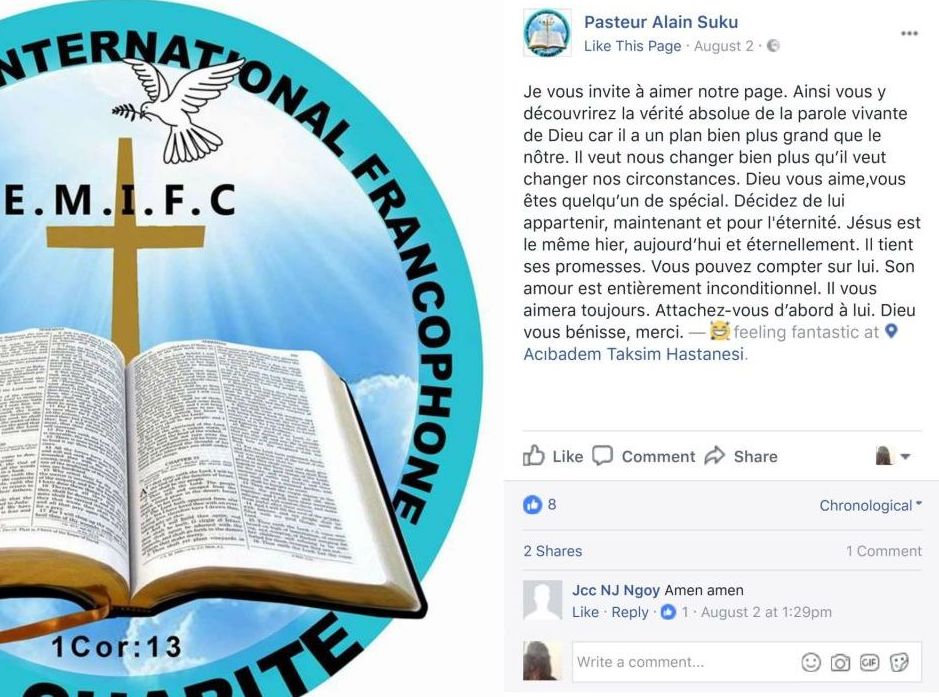
Invitation for a Pentecostal service in Istanbul
Worshipping Along the Routes of Migration: Religion as Infrastructure
Foregoing a traditional notion of infrastructure that focuses solely on architectures and utilities, sociologist Gerda Heck demonstrates how Pentecostal churches have become powerful infrastructural actors that hold together mobile communities between Africa and Europe. Consequently, these sites of religious practice structure where people move and reside along their migratory routes.
There were three of us; we had just crossed the border from Syria to Turkey. And now, we climbed into the back of a truck and ducked behind fruit boxes. It was about four o’clock in the morning when we suddenly stopped in the middle of the road. We heard noises, voices […] I was afraid it was the police. I prayed to God ‘Please God, don’t let them find us!’ They opened the truck and searched for something with a flash-light. [...] They didn’t find us. [...] All of us felt relieved and we started to thank and praise God!
I heard this testimony—offered by a parishioner in front of the church community, thanking God for having helped him cross the border—on one of my first visits to a Congolese-based revival church in Istanbul in spring 2011.Within the scope of the international-interdisciplinary research project “Global Prayers. Redemption and Liberation in the City,” I conducted multi-sited ethnographic field research on the role of (neo-)Pentecostal churches on the migration routes of Congolese migrants. For the current research, of which this essay forms part, field research was carried out in Berlin (Germany), Kinshasa (Democratic Republic of Congo, DRC), Istanbul (Turkey), Rio de Janeiro (Brazil), and Paris (France). During this period, 2011–16, I regularly visited the church community in Istanbul. It was during one of my visits in 2016 that I met Muana Elaka, a Congolese national who was journeying, and I would like to take this opportunity to thank him sincerely for sharing his experiences with me. It reveals two salient connections between religion and migration; the role of faith for the believer on the migration journey as a whole, and, beyond that, the spaces in which religion is practiced at different stages along the migration route. These locations, part of the broader infrastructure, allow believers space to share religious and day-to-day life experiences.
In the last two decades, African charismatic and (neo)-Pentecostal communities have arisen in many European metropolises. At the same time, it has become more and more difficult for many sub-Saharan Africans to emigrate on a legal basis to the global North. Access to global mobility has become one of the most obvious stratifying parameters in today’s global society. The interaction between mobility, restriction, and containment produces a new form of biopolitics, one that puts migrants in a special situation characterized by a form of social hierarchy, which Étienne Balibar (2003) has, already, in the beginning of the millennium, called the “new system of Apartheid.”Ètienne Balibar, Nous, Citoyens D'Europe. Les frontiers, L'État, le peuple. [We, the People of Europe? Reflections on Transnational Citizenship.] Paris: Editions La Découverte, 2001.
Preaching Along the Route
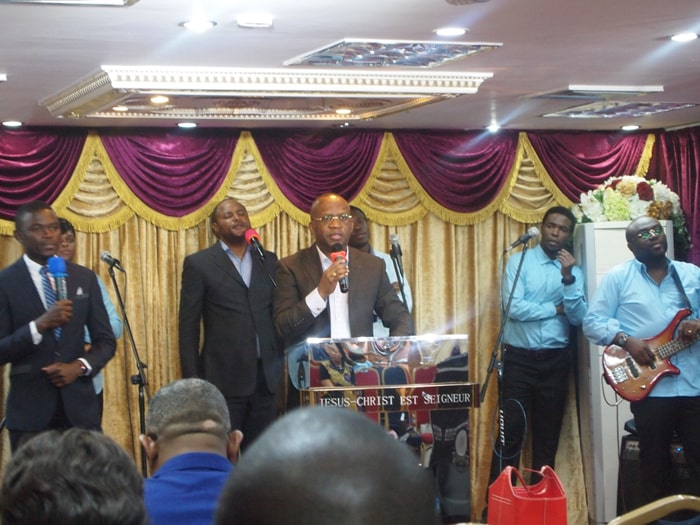
large
align-left
align-right
delete
On a Sunday morning in August 2017, Muana Elaka is preparing himself for church—the Assemblée Chrétienne source de vie, while talking to me via skype. The church is located in Kypseli, a neighborhood in the center of Athens, not far from his current home. About 200, mainly Congolese, but also other French-speaking sub-Saharan African migrants, regularly attend the service of the revival church. It is one of four African churches to have emerged in recent years in Athens. “The number of churchgoers depends on the crossings from Turkey and the Greek islands, and how fast people can travel on toward Northern Europe,” he explains. At the end of each Sunday service Muana asks newcomers to stay behind for a few minutes, and then he gives them an introduction into the main aspects of the church and life in Athens. Muana himself arrived in Athens at the beginning of 2017 with the aim of traveling on toward Northern Europe. Since his arrival in Athens, Muana has become the pastor’s right-hand man, and preaches the gospel in the church twice a week.
Religious Revival in
Democratic Republic of Congo
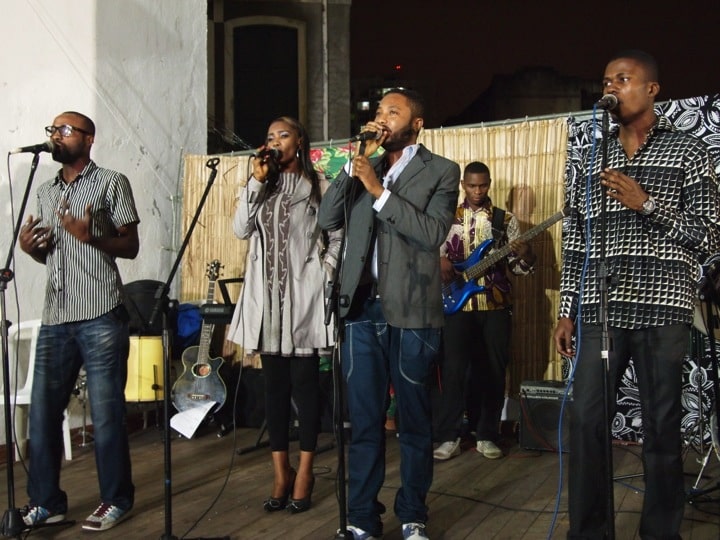
large
align-left
align-right
delete
As in other sub-Saharan African countries, a new global brand of Pentecostalism is heavily influencing the religious culture of Democratic Republic of Congo (DRC). The term “Èglise de réveil” (Revival church), as most of these churches are defined, relates to a religious revival and awakening. This type of church has radically modified the religious landscape of DRC. Revival churches, which emerged at the end of the Mobutu Era, against a backdrop of political instability, economic crisis, and escalating violence, had an effect on many areas of life in DRC, beyond just the religious sphere. Since the early 1990s, the Pentecostal-Charismatic movement has become increasingly influential within Congolese public spheres, and public culture has gradually become more charismatic. Within the new Christian movements, other forms of popular culture and music have been introduced. Theater, music, the plastic arts and media, as well as dance, have all been reinventing and transforming global trends into religious and local forms. The very existence of thousands of churches throughout DRC has altered and reconstructed, not just the public sphere of the infrastructure, but also redesigned the pattern of the social and moral landscape in the country. Among many other notable changes, the new Christian movements have reshaped and blurred the borders between the public and private spheres, accentuating the church environment as a public stage for narratives and testimonies when, in the past, these rituals would have been shared on a more private or family level. Religious discourse and prayer have penetrated almost every facet of private and political life in DRC.Filip de Boeck, “La ville de Kinshasa, une architecture du verbe,” https://lirias.kuleuven.be/bitstream/123456789/197147/3/2007-05-25-deboeck-fr.pdf (accessed December 8, 2017); Alcinda Honwana and Filip de Boeck (eds), Makers and Breakers: Children and Youth in Postcolonial Africa. Woodbridge: Boydell & Brewer, 2005.
Muana Elaka started attending a revival church in Kinshasa at the end of the 1990s. It was in autumn 2015 that he decided to make his way to Europe. The first stop on his journey was Istanbul. Although Muana knew next to nothing about Istanbul, he already knew about a Congolese-based revival church on the Bosporus. Upon arrival there, friends introduced him to the Èglise charité, and shortly after he started to pray and to preach the gospel there.
“You know, you arrive in Istanbul, and at first you think, okay, I’ll rest here for two or three days, and afterwards journey on to Greece,” he tells me. He then continues:
But in the majority of cases, after arriving, things become very different, whether this is because you’ve already run out of money or the prices for the transfer to Greece are too high for you; maybe you need to wait for the best season to cross the Sea. So then you have to find ways to make a living where you are for a while and try not to get too frustrated or depressed. The church is somewhere to meet comrades in the same situation. But moreover, with prayer, you receive the strength and force from God to deal with sometimes almost unbearable situations. Here you reassure yourself, with the help of God, that you will make your way.
For the majority of worshippers, the church represents, along with some other venues, a meeting point for the community and a space to regroup. Moreover, in my interviews, churchgoers emphasized over and over again the different style of spirituality, the (African) way of celebrating, preaching in Lingala and French, the music and the dancing, which “enabled them to experience the ‘power of the divine’” during the service.
Worshipping and Trading
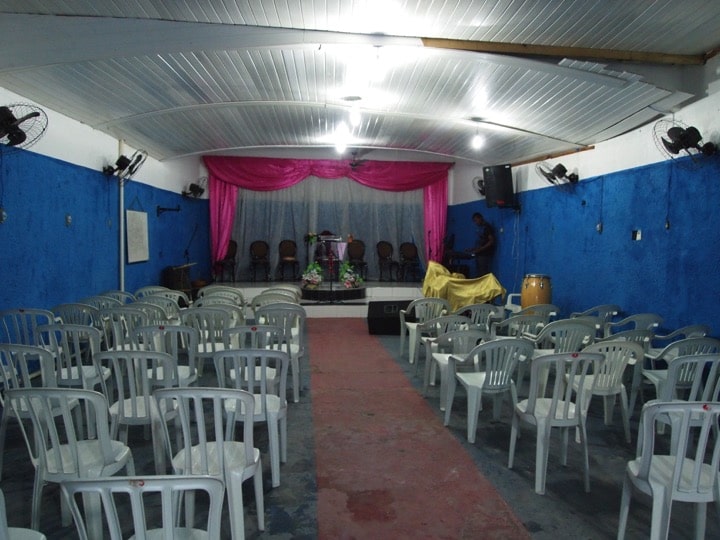
large
align-left
align-right
delete
Attending church on Sunday is regarded as a primary Christian duty. In Istanbul, Muana and other parishioners also took advantage of another aspect of the church. A few years ago, the head of the church, Pastor A., founded, together with some of his parishioners, a small informal business enterprise organizing and intermediating for mostly Congolese, but also other French-speaking sub-Saharan African traders, residing in Europe and in different African countries, and who regularly come to Istanbul. That means, they pick them up at the airport and put them up in a hotel, they accompany them to the sellers, bargain, and translate for them. Most of the traders who come to Istanbul buy clothing or electrical devices. Many of them are believers, and some of them pastors who make use of their stay and preach on Sundays in the Istanbul-based revival church. Due to the constant coming and going of Congolese traders, as well as the transiting of remaining church members, new transnational contacts are established and furthered within the church, which has an effect on the situation of the parishioners locally. Some of them, like Muana, make their living by intermediating for the traders, while residing in Istanbul.
Worshipping at the Detention Center
In spring 2016, Muana and some friends tried to continue their journey from Istanbul to Greece, but they failed, and were deported back to Turkey. While being detained in a Turkish deportation center, they started to organize daily prayers among themselves:
Especially during these kind of situations, you need to gather and pray. Only with God’s blessing can you hope to endure these extremely precarious situations in which you do not know what might happen to you. But, eventually with the help of God and a human rights lawyer, we got released, and as soon as it was possible we journeyed on again and left Turkey.
Worshipping Against the Trauma
Having finally arrived in Athens, Muana already knew where to head next. Through the church, he found a place to stay, and then started to establish himself temporarily once again. Very soon, he realized that the situation in Greece was even worse than before.
Here in Athens many of our parishioners are suffering from depression, some are tired of life, due to the different realities they have had to face while traveling, especially the traumatizing Sea crossing. In addition, unlike in Istanbul, people cannot find any employment here in Greece. So, prayer can help them overcome the depression they feel and give them hope again. Therefore, several times a week, we pray together with the parishioners of all African churches, in the open-air on top of a mountain in the city [...] These are the very strong moments in which we unite with God and the whole of Christianity.
The cosmopolitan philosophy of (neo-)Pentecostal beliefs provides a basis on which the believer can feel part of a global Christian “imagined community,”Benedict Anderson, Imagined Communities: Reflections on the Origin and Spread of Nationalism. London and New York: Verso, 1991. which can also serve as a new spiritual form of a cosmopolitan citizenship. Whether in the detention center or in open-air in Athens, in these gatherings believers further this sense of belonging, which also repudiates the global hierarchy of restrictive border politics they are facing day by day. Moreover, the churches on the migration route provide enormous support and help for migrants in their new urban surroundings, especially from a psychological point of view.
When asking Muana about his future plans, he tells me: “I am preparing to journey on, but let’s see when this happens. I am also still not sure where to go; it depends on the opportunity: Germany, Belgium, or France. I have friends there and know churches all over Europe. So far, I reached Greece, and I know with God’s help I will make my way further on.”
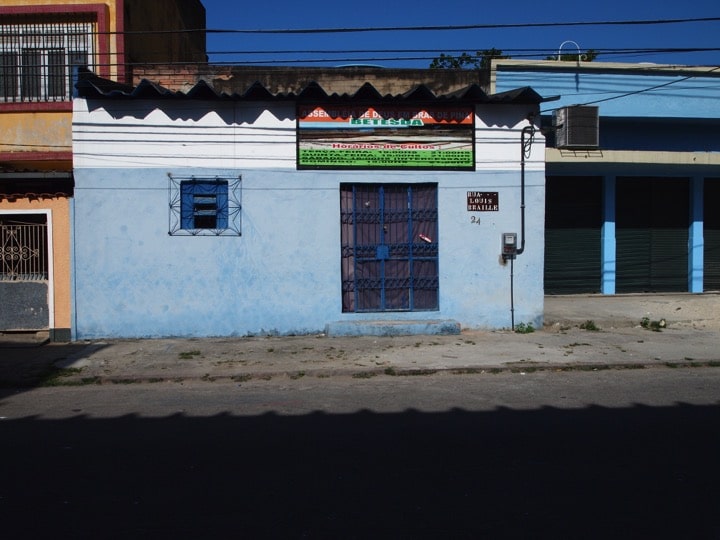
large
align-left
align-right
delete
Like Muana, many of the people I interviewed, are given the strength to continue their journey in the knowledge that an (African) revival church exists in their prospective destination. The parishes and the prayer rooms on the migration routes are used for praying and worshipping, but they also serve as somewhere to withdraw to, a place where information is disseminated, and where migrants can receive practical support. This network of Christian parishes, which expands globally beyond nation-state regulations, provides Congolese believers a vital infrastructure they can tap into during their journey. Drawing on AbdouMaliq Simone, this sophisticated and widely ramified network could also be seen as a process of “worlding from below,” reaching out to a “larger world” through “circuits of migration, resource evacuation and commodity exchange.”Abdou Maliq Simone, “On the Worlding of African Cities,” African Studies Review 44, no. 2 (September 2001), p. 15. With their transnational networks, Congolese revival Christians have created an infrastructure that functions globally: it is a connected assemblage of entangled religious, political, and social practices, of recognizable spaces, symbols, and materialities. One can observe a similar pattern in Simone’s (2008) elaboration of transnational religious networks of African Muslim migrants, in which he notes the importance of Islam as a linking platform for them. Islam, he argues, offers a framework of circulations, in which African-Muslim migrants can easily “establish themselves both at home and abroad, to come and go and to use the resources of stays in the north as a way to change conditions at home.”Abdou Maliq Simone, “The last shall be the first: African urbanites and the larger urban world,” in Andreas Huyssen (ed.), Other Cities, Other Worlds: Urban Imaginaries in a Globalizing Age. Durham, NJ, and London: Duke University Press, 2008, pp. 99–119. Along these lines, religion serves as a reference point, connecting the initiatives, styles, interpretations, and experiences of believers, and offering them the basis for resources to a broader scope of opportunities, even under conditions of discrimination and exclusion.
Everyone—believers, pastors, and preachers—plays a crucial role in this infrastructure. Muana’s experience on the migration route shows that, while hoping to make this journey toward Northern Europe, he engages locally, throughout all the different stages of his journey, in the construction of a charismatic Christian infrastructure. Against the backdrop of ongoing Congolese mobility toward Europe and America, partly in Asia, and in other African countries, a fluid anchoring of Congolese revival churches has evolved in metropolises worldwide. Whether the journey begins in Kinshasa or in Istanbul, one can discover the derived, diasporic infrastructure—extending through time and space, and through different urban settings, countries, and societies—in which sacred spaces are embedded. Within this network, Congolese Christians take either uni- and/or multi-directional routes, making detours, remaining for longer or shorter periods of time in the respective host cities. The circuits are not used solely for the individual purposes of believers; they also imply the production of orientations and their performance. This mobile and multiple anchoring is based on the flexibility and resilience of these migrant believers in response to the overarching power structures of a restrictive global border regime.
Photographs taken by Gerda Heck over the course of her research.